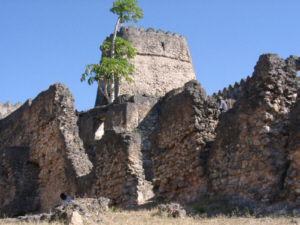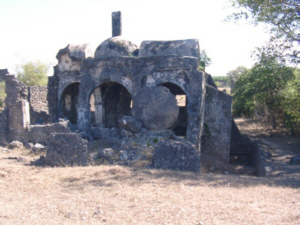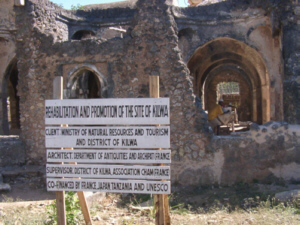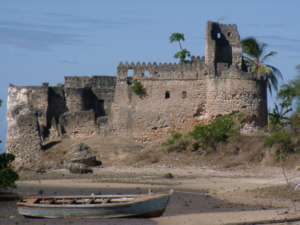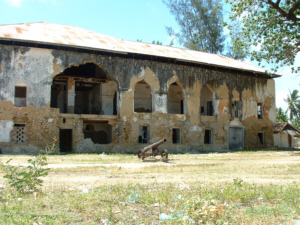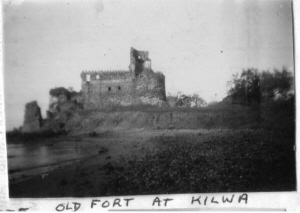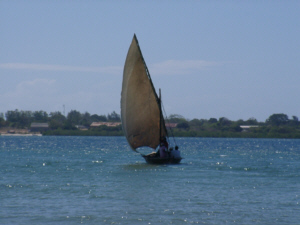Kilwa |
Kilwa Kivinje, Kilwa Masoko and Kilwa Kisiwani with Songo Mnara and Sanje Ya Kiti. Kilwa Masoko is however the least interesting history wise, but the modern town right now, and centre of operations as well as location of all modern day facilities. The others are the places to go for historical reasons.
With the end of the Arab time at the end of the 19th century, the German colonial government built a fort and extended the town.
Kilwa Kisiwani, is where one will find the greatest collection of ruins. Directly on the Northern shore one will
find the old Omani Fort, which is built on the foundations of the old Portuguese fort, in the early 19th Century, and where still an old wooden door remains.
The small mosque from the 15th Century is the best kept building on the island, and still in use today. The large complex of walls in the west of the island is called "Makutani" (in the great wall). In the middle is a palace from the 18th Century, south of it, another Sultanas palace, with a mosque from the 15th Century. All the way to the east of the island there are the ground walls of the "Husuni Kubwa", once the largest building in tropical Africa. Songo Mnara, another island with 14th to 15th Century houses and mosques. Some of which still show high walls and even parts of their roofs. When in Kilwa we stay at the KILWA SEAVIEW RESORT or their site: www.kilwa.net |
Kilwa Masoko ist, aus historischer Sicht, der am wenigsten interessante Ort. Sie ist die heute die modernste Stadt von allen, ist sie doch Heimstatt für alle Möglichkeiten und Angebote einer modernen Stadt. Die anderen werden aufgesucht um die historischen Städten zu besichtigen.
In Kilwa Kisiwani findet man die größte Ansammlung von historischen Ruinen. Unmittelbar am Nordstrand findet man das „Omani Fort“, welches im frühen 19. Jahrhundert auf den Fundamenten des alten portugiesischen Forts erbaut wurde und wo noch die Überreste einer hölzernen Tür zu finden sind. Die große Moschee ist aus dem 12. Jahrhundert. Sie wurde bis zum 15. Jahrhundert weiter ausgebaut. Sie war damals die größte Moschee in Ost – Afrika. Das große Haus direkt südlich der Moschee gehörte einst höchst wahrscheinlich zum Gebäudekomplex des Sultanspalastes. In ihm befinden sich vier Gräber, eines von ihnen wird dem Sultan zugeschrieben. Die kleine Moschee aus dem 15. Jahrhundert ist das best erhaltenste Gebäude der Insel und wird noch heute genutzt. Der große Komplex der Mauern im Westen der Insel wird „Makutani“ ( in der großen Mauer) genannt. In der Mitte befindet sich ein Palast aus dem 18. Jahrhundert. Südlich davon ist ein weiterer Sultanspalast mit einer Moschee aus dem 15. Jahrhundert. Alle Wege führen in den Osten der Insel. Dort befinden sich die Fundamente des „Husuni Kubwa“, einst das größte Gebäude im tropischen Afrika. Songo Mnarna, eine weitere Insel mit Häusern und Moscheen aus dem 14. bis 15. Jahrhunderts. Bei einigen kann man noch hohe Mauern und Teile ihrer Dächer sehen. In Kilwa wohnen wir im KILWA SEAVIEW RESORT oder ihre Seite: www.kilwa.de |
|
|
||||||||||||||||||||||||||||||||||||||||||||||||||||||||||||||||||||||||
